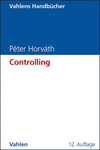Controlling
Zusammenfassung
Der Klassiker zum Controlling.
Controlling: umfassend und bewährt
Auch nach über dreißig Jahren verfolgt dieses Buch weiterhin das ehrgeizige Ziel, mit jeder Neuauflage den »State of the Art« in Wissenschaft und Praxis des Controllings wiederzugeben. Unverändert geblieben ist dabei die Intention dieses Standardwerkes. Es liefert eindeutige Antworten auf drei umfassende Fragen:
* Was ist die Grundidee des Controllingkonzepts?
* Welche Aufgaben umfasst die Controllingfunktion?
* Wie wird die Controllingfunktion organisatorisch realisiert?
Höchste Autoren-Kompetenz
Prof. Dr. Dr. h.c. mult. Péter Horváth gehört zu den renommiertesten Persönlichkeiten im Controlling. Er ist Vorsitzender des Aufsichtsrates einer Managementberatung und Gründungsherausgeber der Zeitschrift für Controlling.
- 1–13 Titelei/Inhaltsverzeichnis 1–13
- 14–89 1. Das Controllingkonzept als Lösungsansatz des Anpassungs- und Koordinationsproblems 14–89
- 14–22 1.1 Das Anpassungs- und Koordinationsproblem 14–22
- 22–29 1.2 Die Aufgaben des Controllers in der heutigen Praxis: Zwei Beispiele 22–29
- 29–31 1.3 Etwas Semantik: Kontrolle, Control, Controlling, Controllership, Controller 29–31
- 31–33 1.4 Die Ursprünge des Controllings 31–33
- 33–34 1.5 Möglichkeiten zur Erkundung des Controllings in der Praxis 33–34
- 34–55 1.6 Controlling in den USA 34–55
- 55–74 1.7 Controlling in der Bundesrepublik 55–74
- 74–80 1.8 Entwicklungstendenzen 74–80
- 80–81 1.9 Zusammenfassung und Ausblick 80–81
- 81–81 Testfragen zu Kapitel 1 81–81
- 81–81 Literaturempfehlung zu Kapitel 1 81–81
- 81–89 Literaturverzeichnis zu Kapitel 1 81–89
- 89–154 2. Das Controllingsystem in der Unternehmung 89–154
- 89–93 2.1 Anforderungen an einen konzeptionellen Ansatz zur Analyse und Gestaltung des Controllings 89–93
- 93–104 2.2 Der Systemansatz als Instrument zur Analyse und Gestaltung der Controllingfunktion 93–104
- 104–105 2.3 Unternehmung als System 104–105
- 105–107 2.4 Das Führungssystem 105–107
- 107–110 2.5 Das Controllingsystem 107–110
- 110–121 2.6 Die Koordination als zentrale Funktion des Controllingsystems 110–121
- 121–134 2.7 Grundlegende Methoden der Koordinationstätigkeit 121–134
- 134–139 2.8 Ergebniszielorientierung des Controllings 134–139
- 139–143 2.9 Das Controlling als ergebniszielorientiertes Koordinationssubsystem der Führung: Zusammenfassende Darstellung unserer Konzeption 139–143
- 143–147 2.10 Konzeptionen des Controllings – Einordnung unseres Controllingansatzes 143–147
- 147–148 2.11 Überblick über die weitere Vorgehensweise 147–148
- 148–148 Testfragen zu Kapitel 2 148–148
- 148–149 Literaturempfehlung zu Kapitel 2 148–149
- 149–154 Literaturverzeichnis zu Kapitel 2 149–154
- 154–302 3. Koordination des Planungs- und Kontrollsystems 154–302
- 154–157 3.1 Der Controller und die Planung und Kontrolle 154–157
- 157–182 3.2 Das Planungs- und Kontrollsystem 157–182
- 182–184 3.3 Aufgaben des Controllings in Bezug auf das PK-System 182–184
- 184–194 3.4 Funktionale Aspekte der PK-Koordination 184–194
- 194–196 3.5 Instrumentale Aspekte der PK-Koordination 194–196
- 196–212 3.6 Organisatorische Aspekte der PK-Koordination 196–212
- 212–267 3.7 Schwerpunkte des PK-Controllings 212–267
- 267–292 3.8 Koordination in Planungs- und Kontrollsystemen der Praxis 267–292
- 292–293 3.9 Zusammenfassung 292–293
- 293–293 Testfragen zu Kapitel 3 293–293
- 293–293 Literaturempfehlung zu Kapitel 3 293–293
- 293–302 Literaturverzeichnis zu Kapitel 3 293–302
- 302–616 4. Koordination des Informationsversorgungssystems 302–616
- 302–307 4.1 Controller und Informationsversorgung 302–307
- 307–317 4.2 Das Informationsversorgungssystem 307–317
- 317–321 4.3 Aufgaben des Controllings in Bezug auf das Informationsversorgungssystem 317–321
- 321–336 4.4 Ermittlung des Informationsbedarfs 321–336
- 336–545 4.5 Informationsbeschaffung und -aufbereitung 336–545
- 545–560 4.6 Informationsübermittlung 545–560
- 560–565 4.7 Wissensmanagement 560–565
- 565–570 4.8 Performance Measurement 565–570
- 570–597 4.9 Koordination von IV-Systemen der Praxis 570–597
- 597–597 4.10 Zusammenfassung 597–597
- 597–598 Testfragen zu Kapitel 4 597–598
- 598–598 Literaturempfehlung zu Kapitel 4 598–598
- 598–616 Literaturverzeichnis zu Kapitel 4 598–616
- 616–702 5. Koordination des computergestützten Informationssystems 616–702
- 616–623 5.1 Controller und Informationssysteme 616–623
- 623–644 5.2 Das Koordinationspotenzial der Informationsverarbeitung 623–644
- 644–680 5.3 Der Koordinationsbedarf der Informationsverarbeitung: IT-Controlling 644–680
- 680–695 5.4 Koordinationspotenzial und Koordinationsbedarf der Informationsverarbeitung in der Praxis 680–695
- 695–695 5.5 Zusammenfassung 695–695
- 695–696 Testfragen zu Kapitel 5 695–696
- 696–696 Literaturempfehlung zu Kapitel 5 696–696
- 696–702 Literaturverzeichnis zu Kapitel 5 696–702
- 702–745 6. Corporate Governance 702–745
- 702–707 6.1 Controlling und Corporate Governance 702–707
- 707–722 6.2 Interne Revision 707–722
- 722–727 6.3 Risikomanagement und -controlling 722–727
- 727–740 6.4 Interne Revision und Risikomanagement in der Praxis 727–740
- 740–741 6.5 Zusammenfassung 740–741
- 741–741 Literaturempfehlung zu Kapitel 6 741–741
- 741–745 Literaturverzeichnis zu Kapitel 6 741–745
- 745–829 7. Gesamtorganisation des Controllings 745–829
- 745–752 7.1 Der Controller in der Organisation 745–752
- 752–758 7.2 Kontextfaktoren für die Controllingorganisation 752–758
- 758–788 7.3 Gestaltungsvariablen der Controllingorganisation 758–788
- 788–797 7.4 Bereichscontrolling am Beispiel des F&E-Controllings 788–797
- 797–803 7.5 Unternehmensnetzwerke und ihr Controlling 797–803
- 803–807 7.6 Anforderungen an die Person des Controllers 803–807
- 807–813 7.7 Einführung und Reorganisation des Controllingsystems 807–813
- 813–822 7.8 Lösungen zu Organisationsfragen des Controllings in der Praxis 813–822
- 822–823 7.9 Zusammenfassung 822–823
- 823–823 Testfragen zu Kapitel 7 823–823
- 823–823 Literaturempfehlung zu Kapitel 7 823–823
- 823–829 Literaturverzeichnis zu Kapitel 7 823–829
- 829–842 Sachverzeichnis 829–842


